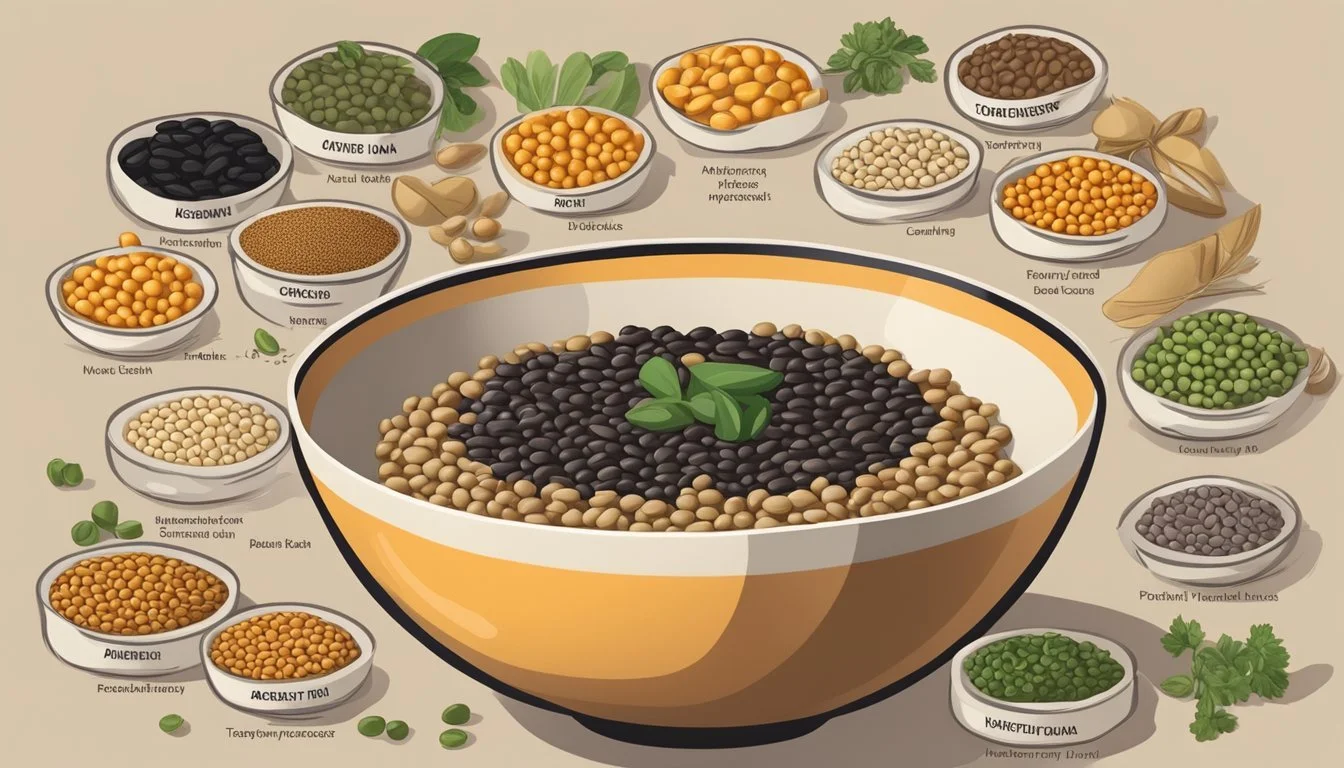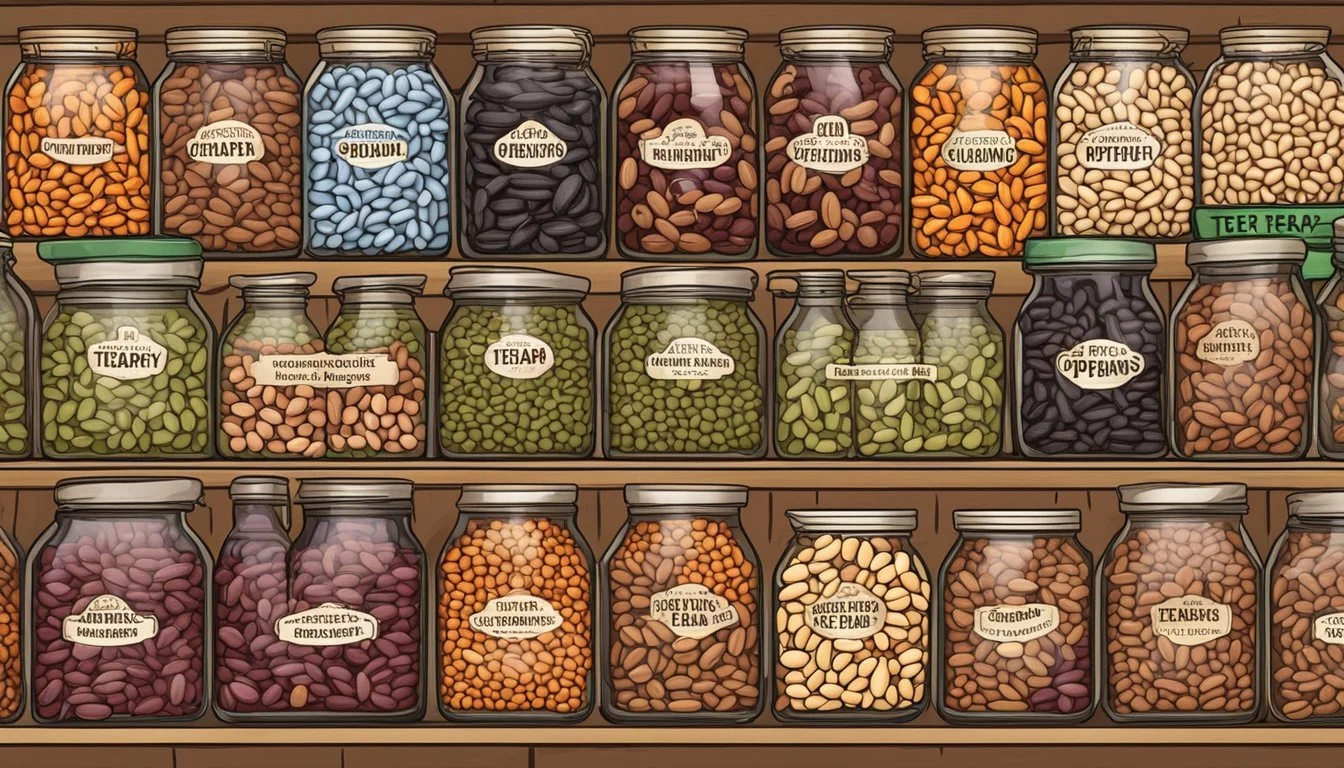Tepary Beans Substitutes
Best Alternatives for Your Recipes
Tepary beans, a staple of Native Americans in the Southwest, are prized for their high protein and fiber content. They thrive in arid climates due to their drought-resistant nature, making them a resilient crop choice. When looking to substitute tepary beans, navy beans are an excellent alternative as they offer similar nutritional benefits and cooking versatility.
Other viable substitutes include great northern beans, which are also rich in protein and fiber, and blend well in soups and stews. For a slightly different texture but comparable flavor, red kidney beans and pinto beans are also suitable options. Each of these alternatives can effectively stand in for tepary beans in various recipes.
Cooking tepary beans involves soaking them overnight and simmering them for up to 90 minutes. This process is similar for many of the substitutes, ensuring a seamless transition in your culinary adventures. By trying different bean varieties, you can discover new flavors and textures while still enjoying the nutritional benefits that tepary beans provide.
History and Origin of Tepary Beans
The tepary bean, scientifically known as Phaseolus acutifolius, has a long and rich history linked to the indigenous peoples of the American Southwest and Mexico. Its drought-resistant qualities have ensured its cultivation for thousands of years, making it a staple in harsh desert climates.
Native American Agricultural Practices
Native American tribes in the American Southwest and Sonoran Desert regions have cultivated tepary beans for centuries. This legume is prized for its ability to thrive in arid conditions, making it a reliable food source in drought-prone areas.
Tepary beans feature prominently in the agricultural practices of tribes such as the Tohono O’odham, who have passed down traditional farming techniques through generations. The cultivation of these beans often involves dry farming methods, relying on minimal water resources. This sustainable approach reflects the deep understanding and adaptation of native peoples to their environment.
Domestication in the Southwest
Tepary beans were first domesticated around 4,000 to 6,000 years ago in Northwest Mexico. Evidence suggests that these beans were derived from wild varieties that still grow in isolated regions of the Sonoran Desert. Archaeological finds, albeit rare, indicate a long history of cultivation and usage.
The beans’ domestication was driven by their superior drought tolerance compared to other legumes. This adaptability suited the harsh desert climates of the American Southwest and northwest Mexico, providing a dependable crop. The domestication process involved selecting plants with desirable traits, ensuring their propagation and continued prominence in local agriculture.
Tepary Beans in Modern Cuisine
Today, tepary beans are experiencing a resurgence in popularity, particularly in cuisines that value sustainability and traditional foods. Their small size and high nutritional content make them a versatile ingredient in various dishes.
Chefs and culinary enthusiasts are incorporating tepary beans into salads, stews, and even desserts, capitalizing on their unique flavor and texture. This renewed interest also aligns with a broader movement towards preserving native crops and promoting food security in arid regions.
The revival of tepary beans in modern cuisine underscores their historical significance and remarkable adaptability, bridging ancient agricultural practices with contemporary culinary trends.
Nutritional Profile
Tepary beans are a nutrient-dense legume rich in protein, dietary fiber, and essential vitamins and minerals. They provide a well-rounded nutritional profile, making them an excellent choice for health-conscious individuals.
Macronutrient Breakdown
Tepary beans offer a balanced combination of macronutrients. A typical serving (1 cup, cooked) contains around 16 grams of protein, making them a solid plant-based protein source.
They provide approximately 44 grams of carbohydrates, predominantly in the form of complex carbs, which contribute to sustained energy release. The fat content is low, with around 1 gram of total fat, primarily consisting of polyunsaturated and monounsaturated fats and negligible amounts of saturated fat.
Vitamins and Minerals
Tepary beans are rich in several vital vitamins and minerals. Each serving contains notable amounts of iron (about 4 mg) and calcium (around 60 mg), aiding in oxygen transport and bone health.
They offer approximately 600 mg of potassium, which helps regulate fluid balance and muscle function. Magnesium and zinc are also present in significant quantities (roughly 50 mg and 2 mg, respectively), supporting metabolic processes and immune function. Tepary beans provide trace amounts of vitamin A and vitamin C as well, enhancing their nutritional value.
Dietary Fiber and Health Benefits
High in dietary fiber, tepary beans offer about 18 grams per cup. This fiber content benefits digestive health, promoting regular bowel movements and reducing constipation.
The soluble fiber in tepary beans can aid in lowering cholesterol levels, thereby supporting heart health. Additionally, their low sodium content makes them a heart-friendly food choice. The presence of complex carbohydrates helps maintain stable blood sugar levels, making them a suitable option for individuals managing diabetes.
Culinary Uses
Tepary beans offer a unique nutty flavor and tender texture that make them versatile in a variety of dishes. They are used in both traditional and contemporary recipes, showcasing their adaptability in different types of cuisine.
Traditional Recipes and Preparations
Tepary beans have been a staple in Native American cuisine for centuries. Common traditional recipes include stews, soups, and chili. The beans are often paired with other indigenous ingredients like corn and squash.
One traditional dish is escomite, a type of succotash made with tepary beans, corn, and squash. The beans are soaked overnight, simmered until tender, and mixed with sautéed vegetables. These dishes highlight the bean’s nutty flavor and its ability to absorb other flavors.
Contemporary Tepary Bean Dishes
Modern culinary uses of tepary beans include salads, hummus, and even refried beans. Their unique flavor and creamy texture make them suitable for a variety of contemporary dishes.
In salads, tepary beans are combined with fresh vegetables and light dressings. For hummus, they are blended with tahini, garlic, and lemon juice for a sweet and nutty taste. As refried beans, they are mashed and cooked with spices, offering a new twist on a classic dish.
Cooking Techniques
Cooking tepary beans requires soaking them overnight to reduce the actual cooking time. Once soaked, they are cooked on the stove in fresh water, brought to a boil, and then simmered for about 90 minutes.
During cooking, they should be watched carefully to prevent sticking. After cooking, they can be used in a variety of dishes. The beans can also be cooked with spices and chorizo, adding layers of flavor and enhancing the dish’s profile with their tender texture and nutty flavor.
Substitute Options for Tepary Beans
Tepary beans, known for their unique flavor and nutritional benefits, can be substituted with several other legumes. Each substitute offers various similarities and differences in taste, texture, and nutritional content.
Similar Legumes and Beans
A variety of legumes can serve as substitutes for tepary beans. Navy beans and northern beans are common alternatives due to their similar size and hearty texture.
Pinto beans and black beans are also suitable substitutes and can be used in recipes requiring a robust flavor. For those seeking a closer match in the nutty taste, brown tepary beans or black tepary beans are ideal.
For a more indigenous substitute, pawi or Papago beans are notable mentions.
Taste and Texture Comparisons
Tepary beans have a distinct nutty flavor and firm texture. Navy beans and northern beans provide a milder taste and softer texture, making them excellent for soups and stews.
Pinto beans offer a slightly earthy taste with a creamy texture, suitable for refried beans. Black beans, known for their robust flavor, add depth to chili and salad dishes.
Brown and black tepary beans maintain the characteristic nutty taste but can vary in firmness, making them versatile for various preparations.
Nutritional Equivalents
Tepary beans are rich in protein and fiber. Navy beans and northern beans also offer high protein and fiber content, making them nutritious substitutes.
Pinto beans provide ample protein, fiber, and essential minerals like iron and magnesium. Black beans are similarly nutrient-dense, containing antioxidants alongside protein and fiber.
For those looking to maintain specific nutritional benefits, brown tepary beans and black tepary beans closely match the original tepary beans in their nutrient profile and health benefits.
Agricultural Characteristics
Tepary beans are well-suited for cultivation in dry climates. They exhibit features that make them resilient in arid environments, require minimal water, and can be easily cultivated using specific farming techniques.
Adaptation to Arid Environments
Tepary beans are particularly adapted to the harsh conditions of the southwestern United States and Mexico. They have been cultivated by indigenous peoples since pre-Columbian times due to their drought-resistant nature.
This legume thrives in areas with low rainfall and high temperatures, thanks to its deep root system. It comfortably grows in the Sonoran Desert where other crops might fail. The bean's growth is optimized in well-drained, sandy soils, further enhancing its suitability for desert environments.
Water Usage and Drought Resistance
Tepary beans are noted for their efficient water usage and remarkable drought resistance. Unlike many other beans, tepary beans can withstand water stress conditions. They can grow with minimal irrigation, making them especially valuable in regions facing water scarcity.
The beans have a shorter growing season, typically maturing within 60 to 90 days. This quick maturation helps them avoid prolonged periods of drought. Their ability to produce yield under low-water conditions is a key characteristic that benefits farmers in arid regions.
Farming Techniques and Harvesting
For successful cultivation, tepary beans should be planted 4 inches apart in rows 12 to 16 inches apart for small-scale operations. Using mechanical planting equipment, rows should be spaced 28-30 inches apart to facilitate field operations for larger-scale production.
The planting depth is crucial and should be maintained at 1-1.5 inches. Generally, a planting rate of 25-30 lb/ac is recommended. Harvesting is done when the pods mature and start to dry, which typically involves manual picking or mechanical harvesting.
Post-harvest handling involves drying the beans thoroughly to avoid spoilage. They come in various colors such as white, brown, and yellow, and are often soaked overnight before cooking to enhance their texture and flavor.
Preservation and Storage
Proper preservation and storage of tepary beans ensure that their nutritional benefits are retained and they remain usable for an extended period. This includes effective drying and storing techniques, understanding shelf life and measures for maintaining freshness, and opting for canned options when necessary.
Drying and Storing Techniques
Drying tepary beans is essential for long-term storage. To dry, spread the beans in a single layer on a flat surface and place them in a well-ventilated, dry area away from direct sunlight. Once dried, store the beans in airtight containers such as glass jars or heavy-duty plastic bags to protect them from moisture and pests.
Consider vacuum sealing for an added layer of protection. Label the containers with the date of storage to keep track of freshness. Properly dried and stored beans can last up to a year without significant loss of flavor or nutrients.
Shelf Life and Freshness
Tepary beans have a relatively long shelf life if stored correctly. In ideal conditions, dried tepary beans can maintain their quality for 1-2 years. To ensure freshness, store the beans in a cool, dark place such as a pantry or cellar. Temperature fluctuations and exposure to light can degrade their quality over time.
Regularly check the stored beans for any signs of spoilage like mold or insect activity. It’s also beneficial to rotate your stock so that older beans are used before newly stored ones. Keeping a log of storage dates can help manage this rotation more effectively.
Canned Tepary Beans
Canned tepary beans offer convenience without compromising too much on nutrition. When opting for canned beans, check for cans with minimal additives and low sodium. Home canning is also an option, utilizing pressure canning methods to ensure safety and longevity.
Store canned beans in a cool, dry place to maximize their shelf life, which typically ranges from 2-5 years. Once opened, transfer any unused beans to a sealed container and refrigerate, consuming within a few days to ensure freshness. This method provides a ready-to-use ingredient, simplifying meal prep while preserving the beans’ nutritional value.







